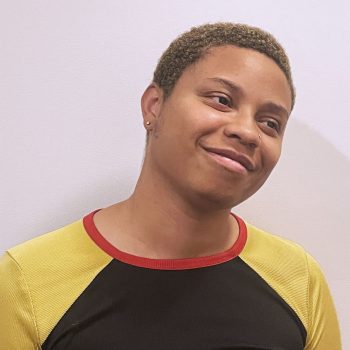
To be experimental or to be not experimental, that is the question many performance artists ask themselves when creating new theater pieces. Experimentation can lead to new ideas, but innovation can also alienate audiences. Arielle Julia Brown, a dramaturg and cultural worker, believes both are possible.
Brown trusts that experimental theater can connect with broad audiences, that seeing and hearing something brand-new encourages people to imagine new futures for themselves and for their communities. This belief grounds the work of Black Spatial Relics (BSR) — of which Brown is the founder and director — an organization that supports and builds connections among artists who create performance pieces about slavery, freedom and justice. The next Convening, where BSR artists will present research and workshops, will take place July 27-30, 2023.
One of Brown’s latest projects is Fallawayinto, a commemorative performance piece that celebrates the life and legacy of her aunt and “transcestor” Donna Nicole Brooker. The piece is set to premiere later this year in Philadelphia. Brown serves many roles in the creative world. At times she is a writer, a performer, a facilitator, an archivist, a researcher, a director, or a curator. She says she has “identified as a multidisciplinary artist” and is “starting to identify with being ‘anti-disciplinary.’” For Brown, having a strong internal mission keeps her grounded. That mission has always been Black liberation.

Logan Cryer: What shaped you into the creator you are today?
Arielle Julia Brown: I think about the lineages of artists that have touched me. I lift up Sharon Bridgforth and Omi Osun Joni L. Jones. I lift up Erik Ehn. I lift up Robbie McCauley.
I grew up in part between Hayward, California, and Atlanta, Georgia. We moved to Atlanta when I was 12. Around the age of 14, I realized that I wanted to make theater for social justice, whatever the fuck that meant. So 20 years ago — I’m 34 now — I started going to this social justice theater in Atlanta, 7 Stages Theater, that programmed and premiered some of June Jordan‘s work. I worked on this play called Maria Kizito by Erik Ehn, which is about the Tutsi genocide in Rwanda.
My learning from that process really brought me into beginning to think about Black struggles transnationally as a young person, as a 15-year-old, and how theater and witness spaces can be a way for us to reconnect to network freedom technologies. And so I can confidently say I’ve been working with this work for about 20 years now and growing with it. It has been a journey. And like I said, I feel very much called by spirit to do this work.
LC: What was happening before Black Spatial Relics came into being?
AJB: So in 2016, I’m in grad school. I was an artist-in-residence with the Center for Reconciliation, which is the space that the Episcopal Diocese of Rhode Island had created. The Episcopal Church in the United States was seeded with money from the slave trade pretty significantly. My understanding is that they’re in a constant conversation about reparations and what that looks like.
In 2016, they had just started the Center for Reconciliation, which was one of their churches turned into a museum. I was initially doing my grad practicum over there, where you have to intern for somebody. And I was like, I’m not an intern. I’m an artist. Dude, make me a position or something!
And so they created this residency. And I just kind of started poking around and learned about these three Black women who were buried under a single footstone in this churchyard. I went through every single archive in the State of Rhode Island that would have anything about them, and gathered those materials and recorded them. Reza Clifton, who was a collaborator on that work and a DJ, we remixed the recordings live and built the performance, The DoubleBack, so we could dream into the gaps of the written archive with our bodies and think about what these three women’s lives were.

At the time, I was really concerned with who gets to tell these stories. Who profits from telling these stories? I want to lift my colleague, Free Bangura. She coined this term“commemorative justice,” which is rooted in the fact that Black people should be the people to be out here telling these stories and collecting whatever coin there is for the telling and sharing and working through these histories. And I think when I was in Providence before, sitting with that, I was really also sitting with those thoughts about who’s profiting from this, who’s considered a legitimate scholar, all of this. What is the space between a public historian and an artist, and a scholar?
At that time, 2016 going into 2017, I felt like there was a rise in the conversations around histories of slavery and the slave trade because we were coming up on 2019 and the quad-centennial of 1619. And so I really was just like, There’s communities of people doing this work in Providence. Clearly, there’s a community of people doing this work nationally, and we should be talking to each other, and we should be showing up in each other’s communities. We’re appropriate to support each other’s work, and we should have money, and we should have space to network ideas. And so that really compelled me to approach Black Spatial Relics as my graduate research, really.
The Center for the Study of Slavery and Justice had an endowed residency that was a $20,000 residency, and for my graduate final project they handed me that resource to be able to build out the first residency iteration of Black Spatial Relics.

LC: How has relocating to Philadelphia changed Black Spatial Relics?
AJB: Many of the artists grants, the micro-grantees, are Philly-based, and we do weigh Philly applications differently. Our last Convening thematically was looking at Philadelphia and its political relationships to the Caribbean, and looking at 19th-century Black presences of Jamaican community in Philadelphia and looking at 18th-century migration of Black Haitian folks to Philly. That, and the 20th century Great Migration, and how important the history of the city is to the global Black freedom struggle.
Moving forward, we’re thinking a lot more about just how poised we are to step into leadership around Black experimental performance, Black radical performance in Philadelphia more generally, and what kinds of programming outside of our residency and Convening and micro-grant program we can be offering and making space for. One of the programs for the Convening this year is this project by Abdul-Aliy Muhammad, Black Reference Chair. We’re working with the theme of Black virtuosic hope and what it is to stir Black virtuosic hope in community here.
I think that for me, if I’m honest, as a non-native Philadelphian, I feel like there is a depth of devotion and pride and love and resilience and faith here. This is such a faithful place [with such a] commitment to community. Artists are purveyors of energy in many directions, and I’m curious about what are the ways in which Black people can come forward and be lifted in ways that sow hope? How can we sit with practices that are long standing, where Black people had to be able to stir up hope inside of themselves?
LC: You have worked as an archivist, documenting culture while also shifting and transforming it at the same time. I imagine there’s sometimes a negotiation or tension between those things.
AJB: Absolutely. I feel like Philly has rehearsed stories about itself, to itself, in ways that calcify and in ways that are absolutely trying to look away from what our life is now. I feel like that bridging is exactly what is so powerful about Black Spatial Relics.
I really think that with Juneteenth becoming a federal holiday, with this kind of cultural renaissance that we’re experiencing, I think that we’ve seen a major shift in how Black histories are talked about. And I don’t think that we have figured out how to not just dust off radical histories, put them behind glass, and just look at them and say, “We’re proud.” How do we do something else with that?
What I love about the artists who come through Black Spatial Relics is that all of them are having those conversations in their communities. It’s not about just excavating the past — that is important — but it’s all about the futures of how Black people get free. It’s really about looking at ancestral practices as roadmaps for how we continue to get more free. So I think that that’s a dream for us about how we operate in community. We want to be asking questions here that disrupt how calcified these things are.
LC: If you could speak directly to someone who has yet to participate or learn from projects like Black Spatial Relics, or other projects that bring radical histories into the present, what would you say?
ABJ: I would say that we’re thinking of them, and we want all the spaces that we make to feel like spaces where they could be home. I work really hard to keep Black Spatial Relics and also my own artistic work accessible, because I just want all Black people to be able to show up at my work and know what the fuck I’m talking. I want that across all of everything that I make. It might not be for all Black people, and it might get me in trouble, and it has, but I never want somebody to show up and not be able to access the work and depart with whatever was for them to leave with.
This story is part of a partnership between The Philadelphia Citizen and Forman Arts Initiative to highlight creatives in every neighborhood in Philadelphia. It will run on both The Citizen and FAI’s websites.







